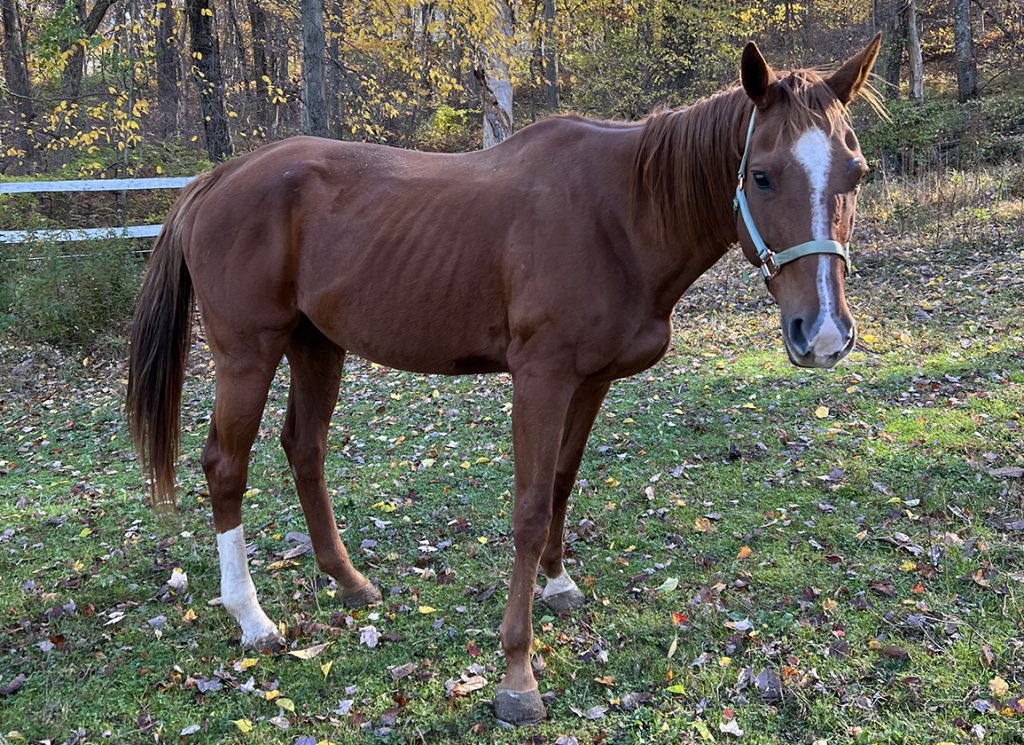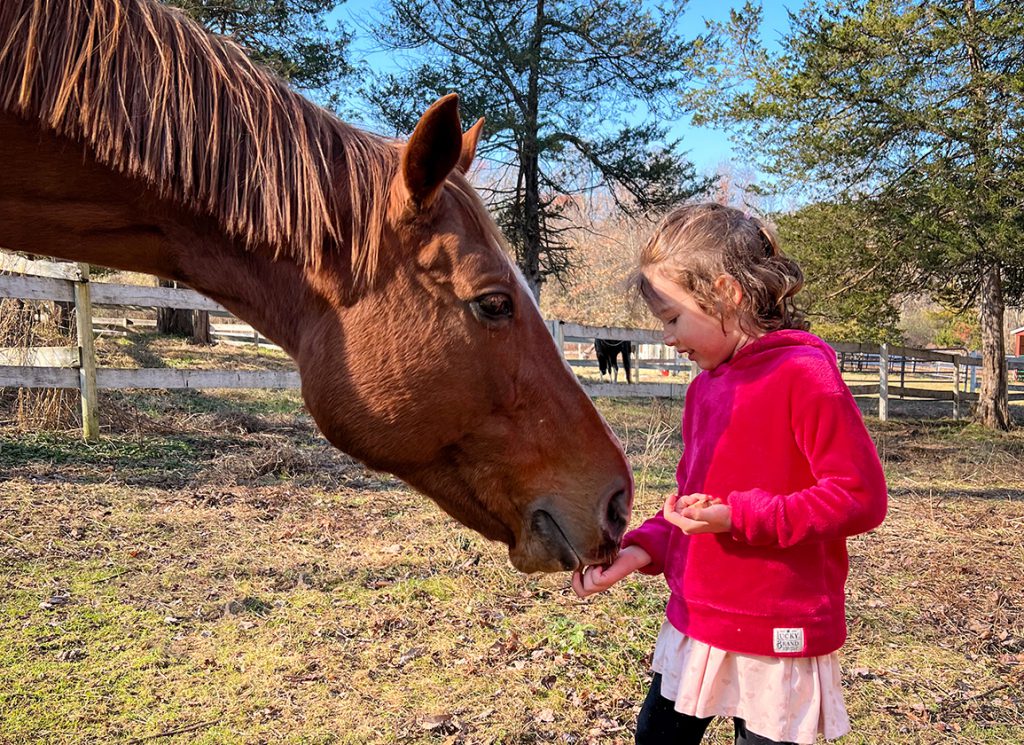A ripple went through social media in mid-March when graded stakes winner The Deputy showed up in a bail pen in Texas.
The post, from a Facebook page called North Texas Feedlot & Auction Horses, showed the 24-year-old stallion still sporting a spray paint hip number from an unknown auction, as well as his Jockey Club papers. Overnight, the post went viral alongside pleas for Thoroughbred rescues and private connections to “bail” the horse out, since North Texas Feedlot and others like it claim horses that are not bailed will be sent for slaughter in Mexico. Then, just as quickly as he'd appeared, the horse was listed as “not available,” and then the post vanished, leaving advocates wondering where he went.
Those who'd followed the saga were pleased to read the news last week that The Deputy had been purchased by his former connections and safely retired. Still, many of them also wanted to know – how did he get there in the first place?
(Read our previous reporting on the bail pen economy here.)
A horse's journey from a racing or breeding home to a bail pen operation is often murky. Horses can change hands frequently between local and regional horse auctions and livestock sales, and may also be sold or traded by horse dealers. By the time they show up in a bail pen or in need of rescue, it's often unclear how they got there. In the case of The Deputy, however, we know what his journey looked like – and it's a classic example of the bail pen economy.
On the racetrack, the Irish-bred son of Petarida (GB) raced in England during his juvenile season before being exported to the United States by Team Valor International and Gary Barber. Jenine Sahadi trained the colt to victories in the 2000 Grade 2 Santa Catalina and G1 Santa Anita Derby, making her the first female trainer to saddle a Santa Anita Derby winner. He was the second wagering choice in that year's Kentucky Derby but finished a disappointing fourteenth.
The Deputy came out of the race with a bowed tendon and was retired to stud at Margaux Farm in Kentucky. The Central Kentucky market is a tough one for stallions, and it's not uncommon for a horse to make the switch to a state with less competition if his offspring aren't well-received at the sales.
The Deputy stood four seasons in Kentucky and never sired a North American graded black type earner. He was sold to stand at Hubel Farms in Michigan ahead of the 2006 breeding season, and he became a reliable stakes sire among state-bred competition, but the downward trajectory of the state's racing and breeding program led to his sale before the 2014 season.
The last facility that advertised the stallion for service to Thoroughbred mares was Rockin' River Ranch in Winterset, Iowa.
When called in the wake of the social media furor earlier this month, Rockin' River owner Wade Feuring told the Paulick Report the stallion hadn't been at his place in five or six years. There had been dwindling interest in the horse among Iowa breeders despite his having sired Tin Badge, the state's champion 2-year-old male of 2017 and The Deputy's highest-earning runner to date. When Feuring got an offer from a Quarter Horse breeder to buy him, he thought it was a perfect fit.
“I'm of the opinion that if they can have a career doing something else, that's the best route to go, which is why we were happy when this gal bought him, because she was going to stand him, breed mares, and give him a life comparable to what he had here; as she must have for the last five or so years,” said Feuring.
Feuring said he learned the horse was in a bail pen because the Facebook page for Rockin' River blew up.
“I woke up this morning, and our Rockin River Ranch has a Facebook page, and the first thing I saw was I had 18 messages, and that's how I first found out,” he said the day after the post was made. “I was shocked to hear all this, because that name hadn't even been mentioned around here in five or six years. I called our Iowa Thoroughbred Breeders and Owners director and secretary, and told them what had happened, and how long it had been since he'd been here, and I was just shocked to hear, just like everybody else. I just thought people should know he didn't go to the kill pen from here.”
Eventually, the social media mob shifted their attention from Feuring, though not after shaming him for (they'd assumed) having a hand in the horse's fate.
Feuring had sold the horse to Jean Davenport of Afton, Iowa, who had purchased The Deputy to cross with Quarter Horses to raise barrel horses. Davenport didn't advertise the stallion because she mostly bred him to her own mares.
“My husband died just about a year ago and I've just been kind of cutting back on my horses,” she said. “I don't have enough time to do chores. I fed him, and taken care of him. I hadn't used him as a stud for over two years. I don't have time to do that, either. I just asked myself the other day, I didn't breed any mares to him last year, I might as well sell him to somebody that'll use him. He's a heck of a producer, he's in really good shape, he doesn't need to go to a kill pen.”
Davenport tapped livestock dealer Mike Gilbert to consign the stallion at the Storm Horse Auction, a mixed-breed horse and tack sale on the grounds of the Humeston Livestock Exchange near the Iowa-Missouri border.
The Deputy hammered for $425.
After the transaction, Gilbert reached out to the winning bidder, Mike Gipson.
“I'd never seen him there before,” said Gilbert. “The sale's not very far from my place, and I'd never seen the gentleman before.
“I asked him where he was going, and he said he was going to a retirement deal. That's about it, really … When they told me he was in a kill pen, I didn't believe it. I don't know a lot about the slaughter market, but they tell me they can't ship stallions. You can't put them on the trucks. I thought they were buying him to do something with him.”
Not only was Gilbert surprised, he said he was furious.
“If [the buyer had] been in my face, I'd have punched him in the mouth, to be honest with you,” he said.
The Deputy's name recognition in the Thoroughbred world meant the post from the North Texas lot spread like wildfire. One of the people who saw it was Whitney Ransom of Conway, Ark., a former exercise rider who watches bail pen pages and occasionally purchases horses to live in retirement on her property.
“I've always had a passion for Thoroughbreds,” she said. “As I got older and saw the other side of the business, it changed my opinion on the racehorse world a lot. I started becoming aware of the fate of a lot of racehorses. You have responsible owners and you have not-responsible owners. I realized it was a cruel world.
“I'll bail one a year or two a year and bring them to my house, or I'll donate to different rescue organizations to try to get them out of these kill pens.”
Ransom was told The Deputy would cost her $1,500, so she said she paid up and made arrangements to have the horse transported and quarantined. The horse's status changed to “not available” on the Facebook page. The next morning, Ransom got a call – the deal was off.
“He said he couldn't sell me the horse and he was going to have to refund my money,” said Ransom. “He wouldn't tell me where the horse was. All he would say is he sent it back where he got it from. I don't know exactly what happened, and I've been pretty upset over the whole deal.
“My first concern is that the horse is safe, but my second concern is that if they'll do this to me for more money, they'll do it to someone else.”
Meanwhile, Team Valor International's Barry Irwin had also been in touch with Gipson as his inbox filled up with messages about the graded stakes winner. Initially, Irwin was told the horse had already sold and was headed to a good home. After another day or so went by, Irwin kept getting calls telling him the horse wasn't actually bailed after all.
“I called the guy back and said, 'Look, can you just tell me the truth about what the hell's going on here? Is the horse gone?'” said Irwin. “He said, 'Nah I got the horse.' I said, 'Did you sell him?' and he said, 'I can get $1,500.' And I said, 'If I give you $3,000, can I have him?'”
Gipson did not respond to a call requesting comment for this story.
Knowing that horses often come out of the livestock auction or bail pen pipeline with profound medical problems, Irwin waited to make any public announcement that he had bailed The Deputy until he knew what he was dealing with. After a thorough veterinary exam at Thoroughbred Aftercare Alliance-accredited Remember Me Rescue, Team Valor, Sahadi, and former co-owner Gary Barber felt comfortable releasing information about the horse's status.
Irwin says he's frequently contacted about horses in a bad position. It's not unusual for racing connections to be roped into a rescue effort on a horse that hasn't legally been theirs for many years. Irwin said he usually handles the situation quietly, but the increasing fervor on social media around ex-racehorses in kill pens isn't making that task easier.
“I'm sure most of these people who I refer to as the 'rescue matrons' are good people. Their hearts are in the right place, but what they do when they start jumping up and down and that creates pressure, which makes it harder for the people like me who want to go in and do the right thing,” said Irwin. “Nobody wants to get ripped off. I've paid as much as $12,500 to rescue a horse. I paid $8,000 once. That's ridiculous, and it's only because people go nuts.”
The incident has left nearly everyone involved frustrated about the lure of the bail pen economy. Increasingly, Thoroughbreds with well-known names or large groups of Thoroughbreds shed in a private dispersal have garnered enormous attention on social media – and enormous profits for bail pen owners. Gipson made $2,575 from The Deputy alone. Gilbert and others who attend livestock auctions say horse prices are at an all-time high right now, perhaps through a combination of greater online access in the wake of COVID-19 and increased interest from people who want to divert a horse out of the slaughter pipeline – or from rescue groups or bail pens who need horses to generate cash.
“Any more, the joke is at a lot of horse sales, there's no more kill pens anymore, everything's a 'rescue,'” said Gilbert. “There was some lady there bragging that she'd gathered $15,000 to rescue horses. I watched people with riding horses put them in the loose, and they brought more than they would have brought riding.”
The post A Graded Stakes Winner Walks Into A Bail Pen, But How Did He Get There? appeared first on Horse Racing News | Paulick Report.
Source of original post


